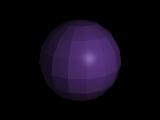



Selects the Blend material type and adds it to the current material in the Material Editor sample window.
The Blend material lets you mix two materials on a single side of the surface.
Blend has an animatable Mix Amount parameter that enables you to draw material morphing function curves to control the way that the two materials are blended over time.
For the Blend material, you can set or modify the following basic parameters:
Material 1 and Material 2: Click to select or create the two materials to be blended.
Use the check boxes to enable or disable the material.
Mask: Click to select or create a bitmap or procedural map to use as a mask. The two materials will blend in greater or lesser degree according to the intensity of the map.
Use the check box to enable or disable the mask map.
Interactive: Selects which of the two materials is displayed on object surfaces in the interactive renderer.
Mix Amount: Determines the proportion of the blend (percentage). 0 means only Material 1 is visible on the surface, 100 means only Material 2 is visible. You can animate this parameter. Create Material Preview is useful for testing the effect. You can also use a map instead of the mix amount.
The two colors will blend in greater or lesser degree according to the intensity of the map.
Control how gradual or how sharp the transition between the two colors being blended will be (this really only has meaning when you have a map applied to Mix Amount). Try blending two standard materials using a noise map as a mask for some interesting mottled effects.
Use Curve: Determines whether the Mixing Curve effects the mix.
Transition Zone: Adjusts the level of the upper and lower limits. If the two values are the same, the two materials will meet at a definite edge. Wider ranges give more gradual blending.
Blend materials have similar controls to Mix maps.
The Browser appears so you can choose a material type.
You can also control the mix amount by using a map.
The Browser appears so you can select a map type.
The intensity of pixels in this mixing map controls the mix. When the intensity is close to zero, one of the component colors or maps is visible; when it is close to full intensity, the other component is visible.
Tip: Using a Noise map for the mixing map can give good effects that have a natural appearance.
In the Mix Parameters rollout, Mix Amount is grayed out while a map is assigned to this parameter. If Use Curve is unchecked, the mixing map is used as is. If Use Curve is checked, you can shift the effect of the mixing map's gradient ramp, offsetting it one way or the other and revealing more or less of the mix components.